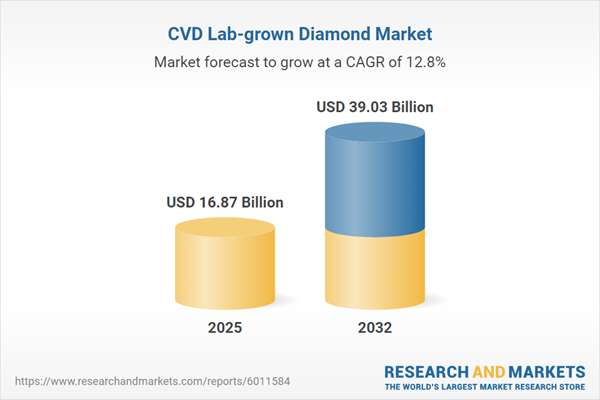Speak directly to the analyst to clarify any post sales queries you may have.
The CVD lab-grown diamond market is undergoing rapid transformation, providing senior leaders with innovative options for sustainable sourcing, operational agility, and tailored solutions across multiple key sectors.
Market Snapshot: CVD Lab-Grown Diamond Market Overview
The global CVD lab-grown diamond market reached USD 14.92 billion in 2024 and is projected to rise to USD 16.87 billion by 2025. It is forecasted to grow at a CAGR of 12.76%, aiming for an estimated value of USD 39.03 billion by 2032. Expansion is tied to the continued advancement of chemical vapor deposition technology, broadening of commercial use cases, and improved supply chain maturity. Senior executives in electronics, manufacturing, and luxury industries are now utilizing synthetic diamond solutions to optimize processes, enhance reliability, and meet evolving user demands.
CVD Lab-Grown Diamond Market: Scope & Segmentation
- Application Areas: Used for thermal management in semiconductor electronics, for producing high-precision cutting tools and optical elements in manufacturing, and extensively in luxury jewelry. Differentiated supplier strategies and branding approaches are required for each sector.
- Carat Weight Categories: Includes options from under 0.5 carat to above 2 carat, allowing organizations to customize inventory and procurement decisions based on specific operational priorities.
- Product Types: Both colorless and fancy colored diamonds are available, supporting a variety of industrial uses and fashion-oriented applications and encouraging innovation across product lines.
- Sales Channels: Offers a mix of offline retail outlets, digital marketplaces, and wholesale distribution channels to meet shifting buyer preferences and enhance supply chain adaptability in line with procurement strategy requirements.
- Regional Coverage: Includes detailed analysis of markets across the Americas, Europe, Middle East and Africa, and Asia-Pacific. This scope enables organizations to assess compliance scenarios and market trends, with focused perspectives on the United States, China, India, Germany, and the United Kingdom.
- Key Companies Profiled: Features De Beers Holding Company Limited, Diamond Foundry, Inc., Pure Grown Diamonds, LLC, IIa Technologies Pte Ltd, Advanced Diamond Technologies, Inc., and ALTR Created Diamonds, Inc., each known for specific methodologies in technology integration and global expansion.
Key Takeaways for Senior Decision-Makers
- Innovations in chemical vapor deposition are enabling new product solutions that fulfill both industrial and luxury sector performance demands.
- Transparent grading standards and traceable supply mechanisms help reinforce supplier trust and streamline procurement practices.
- Sustainable sourcing initiatives are becoming pivotal to environmental stewardship efforts and enhancing accountability in large-scale supply chains.
- Combining digital and traditional sales strategies allows organizations to better respond to market shifts and evolving customer expectations.
- Strategic partnerships with research institutions and technology firms are fueling the exploration of innovative applications, improving readiness for regulatory developments and sector evolution.
Tariff Impact: Navigating US Trade Barriers
Recent changes to US tariffs on CVD lab-grown diamond imports are influencing enterprise sourcing decisions. Organizations are now weighing the benefits of domestic procurement and supplier diversification to achieve greater supply chain flexibility while maintaining a competitive stance amid shifting regulations.
Research Methodology & Data Sources
This report integrates expert interviews from senior industry leaders, detailed technical literature examinations, and focused industry reports. This multi-dimensional research framework provides a solid foundation for actionable, executive-focused insights.
Why This Report Matters
- Guides leadership teams in identifying emerging business prospects and proactively addressing risks resulting from ongoing market change.
- Delivers research-driven guidance on procurement strategies, technology advances, and regulatory responses to support effective decision-making.
- Facilitates benchmarking, offering organizations a basis to assess investment and resource strategies relative to established industry players.
Conclusion
The CVD lab-grown diamond market is evolving through sustained innovation, responsive policy environments, and rising expectations from buyers. Organizations that anticipate industry changes and align their operations are prepared to advance and solidify their competitive positioning.
Additional Product Information:
- Purchase of this report includes 1 year online access with quarterly updates.
- This report can be updated on request. Please contact our Customer Experience team using the Ask a Question widget on our website.
Table of Contents
3. Executive Summary
4. Market Overview
7. Cumulative Impact of Artificial Intelligence 2025
List of Figures
Companies Mentioned
The companies profiled in this CVD Lab-grown Diamond market report include:- De Beers Holding Company Limited
- Diamond Foundry, Inc.
- Scio Diamond Technology Corporation
- Pure Grown Diamonds, LLC
- IIa Technologies Pte Ltd
- Advanced Diamond Technologies, Inc.
- ALTR Created Diamonds, Inc.
- JSC New Diamond Technology
- MiaDonna, Inc.
- ADA Diamonds Sp. z o.o.
Table Information
| Report Attribute | Details |
|---|---|
| No. of Pages | 196 |
| Published | November 2025 |
| Forecast Period | 2025 - 2032 |
| Estimated Market Value ( USD | $ 16.87 Billion |
| Forecasted Market Value ( USD | $ 39.03 Billion |
| Compound Annual Growth Rate | 12.7% |
| Regions Covered | Global |
| No. of Companies Mentioned | 11 |









